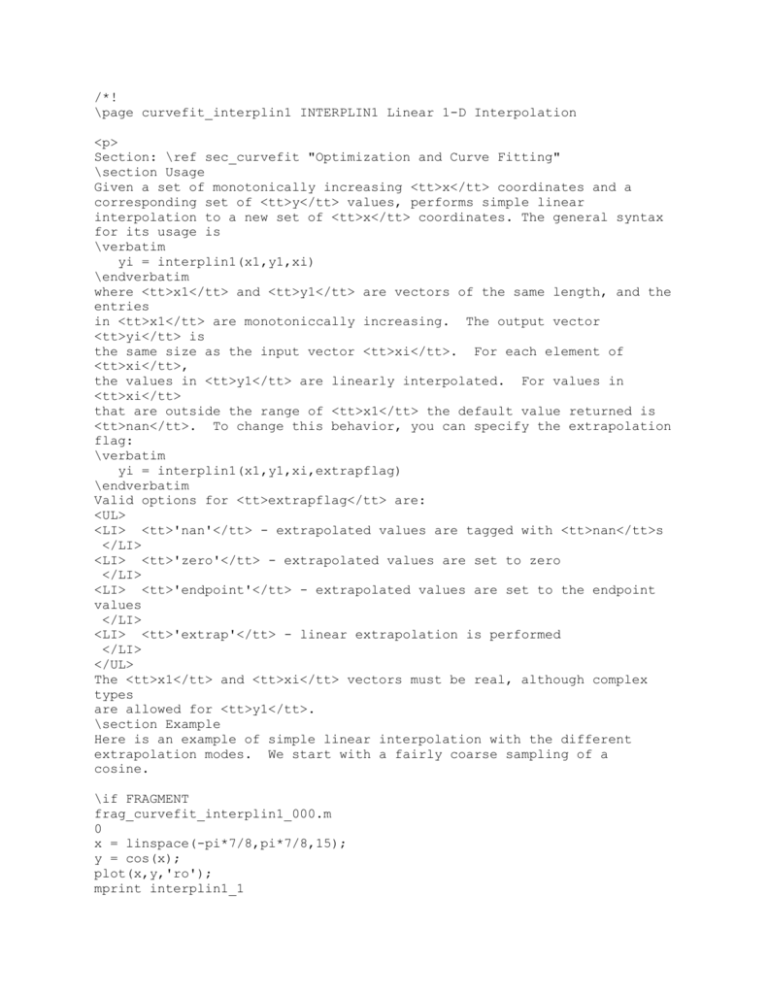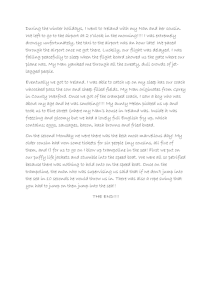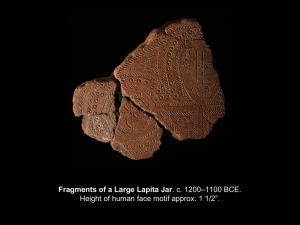\page curvefit_interplin1 INTERPLIN1 Linear 1
advertisement

/*! \page curvefit_interplin1 INTERPLIN1 Linear 1-D Interpolation <p> Section: \ref sec_curvefit "Optimization and Curve Fitting" \section Usage Given a set of monotonically increasing <tt>x</tt> coordinates and a corresponding set of <tt>y</tt> values, performs simple linear interpolation to a new set of <tt>x</tt> coordinates. The general syntax for its usage is \verbatim yi = interplin1(x1,y1,xi) \endverbatim where <tt>x1</tt> and <tt>y1</tt> are vectors of the same length, and the entries in <tt>x1</tt> are monotoniccally increasing. The output vector <tt>yi</tt> is the same size as the input vector <tt>xi</tt>. For each element of <tt>xi</tt>, the values in <tt>y1</tt> are linearly interpolated. For values in <tt>xi</tt> that are outside the range of <tt>x1</tt> the default value returned is <tt>nan</tt>. To change this behavior, you can specify the extrapolation flag: \verbatim yi = interplin1(x1,y1,xi,extrapflag) \endverbatim Valid options for <tt>extrapflag</tt> are: <UL> <LI> <tt>'nan'</tt> - extrapolated values are tagged with <tt>nan</tt>s </LI> <LI> <tt>'zero'</tt> - extrapolated values are set to zero </LI> <LI> <tt>'endpoint'</tt> - extrapolated values are set to the endpoint values </LI> <LI> <tt>'extrap'</tt> - linear extrapolation is performed </LI> </UL> The <tt>x1</tt> and <tt>xi</tt> vectors must be real, although complex types are allowed for <tt>y1</tt>. \section Example Here is an example of simple linear interpolation with the different extrapolation modes. We start with a fairly coarse sampling of a cosine. \if FRAGMENT frag_curvefit_interplin1_000.m 0 x = linspace(-pi*7/8,pi*7/8,15); y = cos(x); plot(x,y,'ro'); mprint interplin1_1 \endif \verbinclude frag_curvefit_interplin1_000.m.out which is shown here \image html interplin1_1.png \image latex interplin1_1.eps "interplin1_1" width=12cm Next, we generate a finer sampling over a slightly broader range (in this case <tt>[-pi,pi]</tt>). First, we demonstrate the <tt>'nan'</tt> extrapolation method \if FRAGMENT frag_curvefit_interplin1_001.m 0 xi = linspace(-4,4,100); yi_nan = interplin1(x,y,xi,'nan'); yi_zero = interplin1(x,y,xi,'zero'); yi_endpoint = interplin1(x,y,xi,'endpoint'); yi_extrap = interplin1(x,y,xi,'extrap'); plot(x,y,'ro',xi,yi_nan,'g-x',xi,yi_zero,'g-x',xi,yi_endpoint,'gx',xi,yi_extrap,'g-x'); mprint interplin1_2 \endif \verbinclude frag_curvefit_interplin1_001.m.out which is shown here \image html interplin1_2.png \image latex interplin1_2.eps "interplin1_2" width=12cm */











